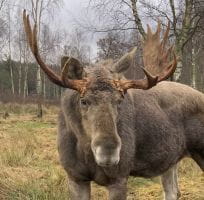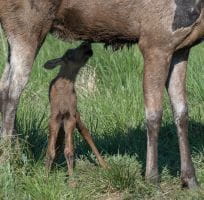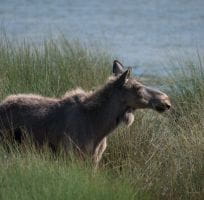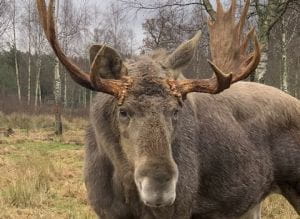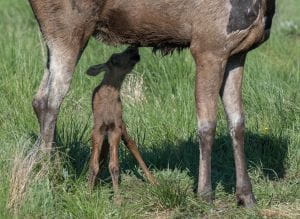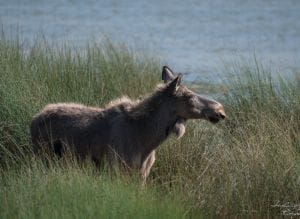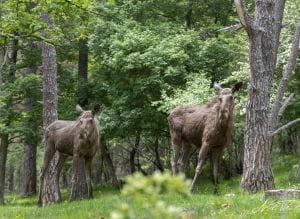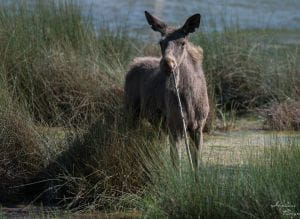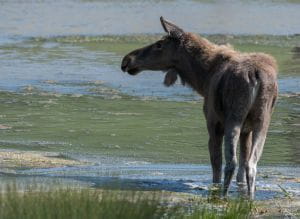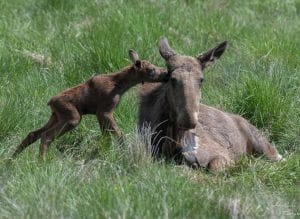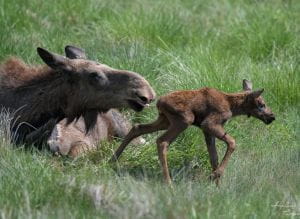The Elk
Alces alces
Etymology is a fascinating science!
The first European settlers to invade Canada were French, which is why Quebec is a French-speaking province. Before invading the northern lands, many fishing expeditions, particularly Basque expeditions, were carried out in the Canadian fjords of the St Lawrence and Labrador (Canadian region). In Basque, the word “oreinak” means “deer”. Moose would therefore be a derivative of the Basque word oreinak!
The word moose has a much more uncertain etymological history!
Be careful not to confuse: the elk (Cervus canadensis) cousin of the elaphe deer (Cervus elaphus) in North America and the moose (Alces alces) same species as the European elk.
Finally, the eland with a d (Taurotragus oryx) is a large antelope from the desert regions of southern Africa.
The eland is the largest cervid today, but it is not the largest cervid the Earth has ever known. Before its extinction (5,000 to 7,000 BC), the Megaceros deer (Megaloceros giganteus) shared the wide open spaces of northern Europe with the European elk before being eradicated by man for its meat and skin. It measured 2 metres at the withers and weighed up to 600 kg for the heaviest individuals. Its most impressive feature was its antlers, which could reach a wingspan of 3.5 metres!
The European elk found refuge in the far north of Europe and North America. However, palaeontologists have found European elk bones as far afield as the Mediterranean basin, proving that this animal was present throughout Europe before modern man arrived and disrupted its range.
Until the Middle Ages, the European elk was still common in the forests of Western Europe (France, Germany, Belgium, Switzerland and northern Italy), as was the Auroch (a wild European bovid, now extinct). It was mainly hunted for its meat and hide. In Central Europe, it survived until the 18th century. Today, it is only found in the wild in Scandinavia and Siberia.
A funny look
The elk’s appearance may come as a surprise. Its short body is carried by very long limbs. Large ears and an imposing domed snout surround surprisingly small eyes. Its general appearance is a cross between a horse and deer.
It generally trots to get around, but to escape danger, it switches to a gallop, which allows it to reach speeds of up to 50 km/h, even in powdery snow thanks to its long legs.
Finally, let’s not forget its swimming skills, which it uses to search for food underwater.
When it comes to clothing, it has a very thick coat in winter. Now let’s talk about headgear. As with most cervids, the male has proud antlers, sometimes spanning two metres. In places, they are flattened, which is a characteristic of the species.
What is the purpose of these antlers, which are rather heavy to carry and impractical to walk around in the forest? To show off their virility, of course.
As biologist Vince Crichton explains, the more imposing they are, the more it shows females that he will be the perfect father for their children. More often than not, without even fighting, the male with the most antlers can look forward to a very successful rutting season.
Once the males have been showered with love, or not, their antlers serve no purpose other than to clutter them up. So they get rid of them between November and December. It’s only in April, in the spring, that they start to worry about their love affairs with the regrowth of antlers. This re-growth is even more rapid than in deer. It can grow up to twenty centimetres every nine days.
A solitary life
The European Elk is a loner. Unlike most Cervids, this species does not form herds.
In early summer, the males start rubbing their antlers against the trees to rid them of their velvet, and by August they are sporting impressive brown pallets capable of knocking the ladies off their feet.
In September, the male joins a female, attracted by the long wails she emits, which he can hear over 3 kilometres away thanks to his exceptional hearing!
All that’s left for him to do is put on some perfume. Between late September and early October, he digs small pits in the ground into which he urinates. It then vigorously kicks the pit to spray the urine onto its antlers.
The male is ready for a much quieter love life than other cervids, content with a single fiancée!
The intoxicating scent given off by the urine-stained antlers triggers the female’s ovulation cycle.
The following spring, after a gestation period of 8 months, the female will give birth to 1 calf, more rarely two.
Infested in aquatic environments
According to the Paris National Museum of Natural History, the European Elk does not tolerate heat well and often cools down in lakes and rivers. An excellent swimmer, it covers considerable distances in water. By blocking its nostrils (using small valves), it can dive to depths of up to 6 metres and remain submerged for up to 8 minutes to graze on cellulose-rich aquatic plants at the bottom of swamps. It is considered a semi-aquatic animal in Canada, because it spends so much time in the water! In summer, it takes refuge in rivers or lakes to escape the constant attacks from flies, ticks and horseflies.
The elk prefers to live in wetlands, where its hearty appetite means it enjoys a wide variety of herbivorous foods: grasses, aquatic plants, the foliage and bark of many trees and shrubs, lichen, mosses, etc. It does, however, have a clear preference for the young branches, shoots and leaves of willows and birches in spring and summer. In winter, it can make do with pine needles and bark.
It has an excellent sense of smell, which enables it to find its food under the snow in winter.
In Canada, naturalists have described a surprising mutualism between the Canadian beaver and the moose. The deer feeds on the freshly fallen trees that the beaver uses for its dams!
A new arrival in the acclimatisation phase
The three females we present arrived from Sweden on 21 November 2019, while it was snowing. No doubt to avoid a change of scenery!
They were temporarily placed in an adaptation enclosure in order to introduce them to the other species in the Reserve, as well as to visitors. From the outset, our goat kids found these new arrivals … big, very big, but friendly. They quickly got into the habit of coming to share their meals.
They were temporarily placed in an adaptation enclosure in order to introduce them to the other species in the Reserve, as well as to visitors. Our goat kids immediately found these new arrivals … big, very big but friendly. They quickly got into the habit of coming to share their meals.
The bison were very intrigued by these new arrivals. There were many exchanges during the winter, but it has to be said that this mutual curiosity has gradually disappeared and is now nothing more than polite indifference.
As for the Przewalski’s horses, they once again confirmed their bad temper, only approaching the elanes to better try to kick them!
In May 2020, quite a surprise
Our three females found themselves quite lonely throughout the winter of 2019-20 as the husbands we had found for them had remained stranded in their countries of origin due to Covid-19. Nevertheless, we were surprised to discover on 22 May 2020 a tiny 50-centimetre-tall head of cabbage in the females’ enclosure! One of them must have made a mistake before joining us… Armed with a bad temper, she turned into a gentle, attentive mother.
